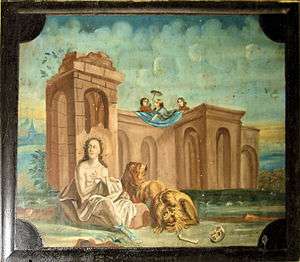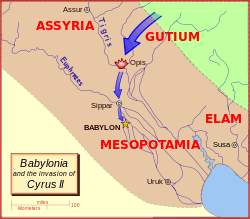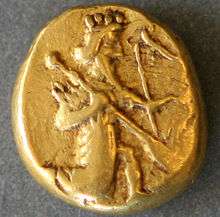Darius the Mede

Darius the Mede is mentioned in the Book of Daniel as king of Babylon between Belshazzar and Cyrus the Great, but he is not known to history, nor can he be fitted between the known figures of Belshazzar and Cyrus.[1] Most scholars view him as a literary fiction, but conservatives seeking to harmonise Daniel with history have put forward several theories, the most common being that he is identical with either Cyrus or with Ugbaru, the general who was first to enter Babylon when it fell to the Persians in 539 BCE.[2]
Darius the Mede in the Book of Daniel
Darius the Mede is first mentioned in the story of Belshazzar's feast (Daniel 5). Belshazzar, king of Babylon, holds a great feast for his lords, but in the midst of the revelries a hand appears and writes on the wall: MENE, MENE, TEKEL, PARSIN. Daniel interprets the mysterious words: Belshazzar has been weighed and found wanting, and his kingdom is to be divided between the Medes and Persians. The story concludes: "That very night Belshazzar the Chaldean (Babylonian) king was killed, and Darius the Mede received the kingdom."[3]
In the story of Daniel in the lions' den (Daniel 6), we learn that Daniel has continued to serve at the royal court under Darius, and has been raised to high office. His jealous rivals plot his downfall, tricking Darius into issuing a decree that no prayers should be addressed to any god or man but to Darius himself, on pain of death. But Daniel continues to pray to the God of Israel, and Darius, although deeply distressed, must condemn him to be thrown into the lions' den, for the edicts of the Medes and Persians cannot be altered. At daybreak the king hurries to the place and cries out asking if God had saved his friend, and Daniel replies that his God had sent an angel to close the jaws of the lions "because I was found blameless before him." Darius commands that those who had conspired against him should be thrown to the beasts in his place, along with their wives and children.[4]
The final appearance of Darius is in Daniel 9. This chapter records a vision of Daniel relating to the end-time travails and triumph of the Israelites over their enemies, and the mention of Darius is simply a chronological marker: the vision, the reader is told, was sent to Daniel in "the first year of Darius son of Ahasuerus" (the Hebrew form of Xerxes).[5]
Historical and literary background

The Medes and the fall of Babylon
The Medes came to prominence in 612 BCE when they joined with the Babylonians in overthrowing Assyria. Little is known about them, but they were possibly a significant power in the Middle East for several decades thereafter. The fall of their empire is recorded in a Babylonian inscription from around 553 BCE (a second report puts the event in 550 BCE) reporting that the Median king has been conquered by "Cyrus, king of Anshan," in south-western Iran: this is the first appearance of Cyrus in the historical record, and the beginning of the rapid rise of the Persians.
After extending his empire from the Mediterranean to Central Asia, Cyrus turned his attention to Babylonia. The most important ancient sources for his conquest of Babylon are the Nabonidus Chronicle (Nabonidus was the last Babylonian king, and Belshazzar, who is described as king of Babylon in the Book of Daniel, was his son and crown prince), the Cyrus Cylinder, and the Verse Account of Nabonidus - which, despite its name, was commissioned by Cyrus.[6]
Cyrus' Babylonian campaign began in 539 BCE, although there were presumably previous tensions. On 10 October Cyrus won a battle at Opis, opening the road to Babylon, and on 12 October "Ugbaru, governor of the district of Gutium, and the army of Cyrus entered Babylon without a battle" (Babylonian Chronicle). Ugbaru is presumably the same person as the Gorbyras mentioned by the Greek historian Xenophon, a Babylonian provincial governor who switched to the Persian side. Cyrus made his entrance into the city a few days later; Nabonidus was captured and his life spared, and nothing is known of the fate of Belshazzar.[7]
The Book of Daniel
The Book of Daniel is not regarded by scholars as a reliable guide to history.[8] The broad consensus is that Daniel never existed, and that the author appears to have taken the name from a legendary hero of the distant past mentioned in the Book of Ezekiel.[9][10] Daniel is an apocalypse, not a book of prophecy, and its contents form a cryptic allusion to the Syrian Greek king Antiochus IV Epiphanes (reigned 175–164 BCE) and his savage persecution of the Jews.[11][12] There is broad agreement that the stories making up chapters 1-6 are legendary in character, and that the visions of chapters 7-12 were added during the persecution of Antiochus, the book itself being completed soon after 164 BCE.[13]
Daniel 5 and Daniel 6 belong to the folktales making up the first half of the book.[14] The language of Daniel 5 ("Belshazzar's Feast"), for example, follows ancient Near eastern conventions which are in some cases precisely those used in Daniel.[15] Daniel 6 ("Daniel in the Lions' Den") is based on a classic Babylonian folk-tale called "Ludlul-bel-nemeqi", telling of a courtier who suffers disgrace at the hands of evil enemies but is eventually restored due to the intervention of a kindly god (in the story in Daniel, this is the God of Israel): in the Babylonian original the "pit of lions" is a metaphor for human adversaries at court, but the biblical tale has turned the metaphorical lions into real animals.[16]
In Daniel 9 Daniel, pondering the meaning of Jeremiah's prediction that Jerusalem would remain desolate for seventy years, is told by the angel Gabriel that the 70 years should be taken to mean seventy weeks (literally "sevens") of years.[17] Verse 1 sets the time of Daniel's vision as the "first year of Darius son of Ahasuerus, by birth a Mede",[18] but no Darius is known to history, nor can he be fitted between the genuine historical figures of Belshazzar and Cyrus.[1]
Identity of Darius the Mede

Many attempts have been made to connect Darius the Mede to known figures, but H.H. Rowley's 1935 study of the question (Darius the Mede and the Four World Empires of Darius the Mede, 1935) demonstrated that each was a false identification, and most commentators view him as a literary fiction. This leaves open the question of where the author of the Book of Daniel found his Darius. The following is a list of the most common candidates:[2][19]
- Darius the Great (Darius I Hystaspes), c. 550–486 BCE. This historically known Darius was the third Persian emperor, and an important figure for Jews in the early Persian period because of his role in the rebuilding of the Temple in Jerusalem.[20] At the beginning of his career Darius had to (re)conquer Babylon to remove a usurper, before expanding the empire and dividing it into satrapies.[21][22] The author of Daniel, mindful of certain prophecies that the Medes would destroy Babylon (Jeremiah 51:11,28 and Isaiah 13:17), and needing a Median king to complete his four-kingdom schema (see the story of Nebuchadnezzar's dream in Daniel 2), appears to have taken the historic Darius and projected him into a fictional past.[22]
- Astyages. Astyages was the last king of the Medes; he was defeated by Cyrus in 550 (or 553), his father was named Cyaxares (not Ahasuerus/Xerxes), and there is no record of him being present at the fall of Babylon. Consequently, he gets little attention in modern apologetics, but the 1st century CE Jewish historian Joseph, followed later by the early Christian Church Father Jerome, harmonised Daniel with the historical sources by claiming that Darius the Mede was a son of Astyages.[23][22]
- "Cyaxares II". The Greek writer Xenophon tells of a Median king called Cyaxares who was the son of Astyages - other Greek historians say that Astyages had no son. According to Xenophon, Cyrus became king of Media through marriage to Cyraxares' daughter – contradicting all other sources, notably the Babylonian, which say Cyrus won Media by conquest from Astyages. Xenophon is not given credence by historians, and he does not, in any case, say that his otherwise unknown Cyraxares ruled Babylon.[24]
- Cyrus. This argument hinges on a reinterpretation of Daniel 6:28 to read "Daniel prospered during the reign of Darius, even the reign of Cyrus the Persian", making them the same individual. William Shea, a conservative scholar, comments that it would be strange to refer to Cyrus the Persian, son of Cambyses I, as Darius the Mede, son of Ahasuerus, and strange also to refer to the same king as Cyrus in some passages and Darius in others.[25]
- Cambyses II. Cambyses was Cyrus' son and his successor as emperor. The Babylonian records indicate that Cyrus installed him as regent in Babylon, but he was not a Mede, his father was not Ahasuerus, and he was probably not 62 years old.[26]
- Gubaru (or Ugbaru, the Gorbryas in Greek sources), the general who was the first to enter Babylon. Ugbaru was the Babylonian governor of Gutium (an area closely associated with Media in Babylonian sources) before switching sides to the Persians, and Cyrus seems to have given him administrative responsibility for Babylon after its capture. He did not, however, hold the title of "King of Babylon", nor does this theory account for the name Darius.[27][19]
References
Citations
- 1 2 Coleman 1990, p. 198.
- 1 2 Hill 2009, p. 114.
- ↑ Seow 2003, p. 74-75.
- ↑ Seow 2003, p. 85-86.
- ↑ Knibb 2006, p. 435.
- ↑ Waters 2014, p. 38-39,43.
- ↑ Briant 2002, p. 41-42.
- ↑ Collins 2002, p. 1.
- ↑ Collins 1999, p. 219-220.
- ↑ Seow 2003, p. 3-4.
- ↑ Collins 1984, p. 29.
- ↑ Noegel & Wheeler 2002, p. 74.
- ↑ Collins 2002, p. 2.
- ↑ Mobley 2012, p. 135-136.
- ↑ Paul 2002, p. 59.
- ↑ Van Der Toorn 2001, p. 43.
- ↑ Collins 2003, p. 75.
- ↑ Levine 2010, p. 1251 fn.9.1-19.
- 1 2 Newsom & Breed 2014, p. 192.
- ↑ Collins 2002, p. 95.
- ↑ Briant 2002, p. 115.
- 1 2 3 Newsom & Breed 2014, p. 191-192.
- ↑ Shea 1982, p. 231.
- ↑ Shea 1982, p. 231-232.
- ↑ Shea 1982, p. 232-233.
- ↑ Shea 1982, p. 233.
- ↑ Shea 1982, p. 234-235.
Bibliography
- Briant, Pierre (2002). From Cyrus to Alexander: A History of the Persian Empire. Eisenbrauns.
- Coleman, G. Byrns (1990). "Darius". In Mills, Watson E.; Bullard, Roger Aubrey. Mercer Dictionary of the Bible. Mercer University Press.
- Collins, John J. (1984). Daniel: With an Introduction to Apocalyptic Literature. Eerdmans.
- Collins, John J. (1998). The Apocalyptic Imagination: An Introduction to Jewish Apocalyptic Literature. Eerdmans.
- Collins, John J. (1999). "Daniel". In Van Der Toorn, Karel; Becking, Bob; van der Horst, Pieter Willem. Dictionary of Deities and Demons in the Bible. Eerdmans.
- Collins, John J. (2002). "Current Issues in the Study of Daniel". In Collins, John J.; Flint, Peter W.; VanEpps, Cameron. The Book of Daniel: Composition and Reception. I. BRILL.
- Hill, Andrew E. (2009). "Daniel-Malachi". In Longman, Tremper; Garland, David E. The Expositor's Bible Commentary. 8. Zondervan.
- Knibb, Michael (2006). The Septuagint and Messianism. Peeters Publishers.
- Levine, Amy-Jill (2010). "Daniel". In Coogan, Michael D.; Brettler, Marc Z.; Newsom, Carol A. The new Oxford annotated Bible with the Apocryphal/Deuterocanonical books : New Revised Standard Version. Oxford University Press.
- Mobley, Gregory (2012). The Return of the Chaos Monsters. Eerdmans.
- Newsom, Carol A.; Breed, Brennan W. (2014). Daniel: A Commentary. Presbyterian Publishing Corp.
- Noegel, Scott B.; Wheeler, Brannon M. (2002). Historical Dictionary of Prophets in Islam and Judaism. Scarecrow Press.
- Paul, Shalom (2002). "Mesopotamian Background of Daniel 1-6". In Collins, John J.; Flint, Peter W.; VanEpps, Cameron. The Book of Daniel: Composition and Reception. I. BRILL.
- Seow, C.L. (2003). Daniel. Westminster John Knox Press.
- Shea, William H. (Autumn 1982). "Darius the Mede: An Update". Andrews University Seminary Studies. Andrews University Press. 20 (3): 229–247.
- Van Der Toorn, Karel (2001). "Scholars at the Oriental Court". In Collins, John J.; Flint, Peter W.; VanEpps, Cameron. The Book of Daniel: Composition and Reception. I. BRILL.
- Waters, Matt (2014). Ancient Persia: A Concise History of the Achaemenid Empire, 550–330 BCE. Cambridge University Press.